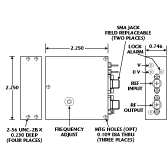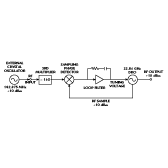An Externally Referenced 23 GHz DRO
Delphi Components Inc.Laguna Niguel, CA
Dielectric resonator oscillators (DRO) are highly stable fundamental oscillators in the 3 to 30 GHz region, achieving free-running frequency stability of less than 1 ppm/°C in many cases. DROs also exhibit very low phase noise characteristics at 100 kHz from the carrier and beyond, making them suitable for low noise applications. A common method of improving oscillator phase noise close to the carrier utilizes a phase-locking technique that locks the DRO to a highly stable crystal source, thus taking advantage of the crystal oscillator’s improved phase noise characteristics close to the carrier.
To take full advantage of the DRO characteristics and the close-in stability of the crystal reference oscillator, an externally referenced, phase-locked, 23 GHz fundamental DRO has been developed that features good stability, low phase noise and high power output. The model DE228-01 externally referenced DRO operates at 22.86 GHz and produces greater than 17 dBm of output power. The oscillator’s phase noise is less than –108 dBc/Hz at 100 kHz offset, less than –128 dBc/Hz at 1 MHz offset and less than –150 dBc at 10 MHz offset. Close to the carrier the phase noise is that of the 142.875 MHz external crystal reference oscillator degraded by 20log(N) + 3 dB, where N is the multiplication factor of the crystal oscillator to the DRO’s output frequency. In this case N = 160, providing a phase noise degradation of 47 dB.
A fundamental 23 GHz DRO greatly simplifies the oscillator circuitry, eliminating costly frequency multipliers that add significantly to the space required.  As a result, the externally referenced DRO is housed in a compact 2.25" square by 0.746" package, as shown in Figure 1 . The RF output and reference input connectors are SMA-F and the DC supply, lock alarm and ground are solder pins.
As a result, the externally referenced DRO is housed in a compact 2.25" square by 0.746" package, as shown in Figure 1 . The RF output and reference input connectors are SMA-F and the DC supply, lock alarm and ground are solder pins.
Figure 2 shows the externally referenced DRO’s block diagram.  An internal step-recovery diode (SRD) multiplies the 142.875 MHz input signal, which is supplied by the external crystal oscillator, by 160. The multiplied reference is then phase compared in the phase detector to a DRO sample, and a DC correction voltage is generated and applied to the DRO’s tuning port for phase control.
An internal step-recovery diode (SRD) multiplies the 142.875 MHz input signal, which is supplied by the external crystal oscillator, by 160. The multiplied reference is then phase compared in the phase detector to a DRO sample, and a DC correction voltage is generated and applied to the DRO’s tuning port for phase control.
The DE228-01 features harmonic levels less than –40 dBc and spurious levels less than –80 dBc. For system fine-tuning the phase-locked DRO is tuned mechanically over a greater than or equal to ±20 MHz frequency range. The source operates from a +15 V DC supply at less than or equal to 500 mA. Operating temperature range is –40° to +70°C. Power stability over this temperature range is less than or equal to ±1 dB and the output SWR is less than or equal to 2. The external crystal reference power required at the input is +10 dBm. A TTL alarm output provides 5 V to indicate a lock.
This combination of a high power fundamental DRO and phase-locked crystal reference provides an unusually clean source for use in up- and downconverters where digital modulation techniques are employed and low bit error rates are required. Systems utilizing multiple, closely spaced channels benefit from this locked DRO technique. Such high frequency oscillators are used in up- and downconverters for video delivery systems, digital microwave radios, personal communications services systems, local multipoint distribution service equipment and other wireless communications systems. Similar DROs at other microwave frequencies, both externally referenced and with an internal oven-controlled crystal oscillator, are available on request.
Delphi Components Inc., Laguna Niguel, CA (714) 831-1771.
